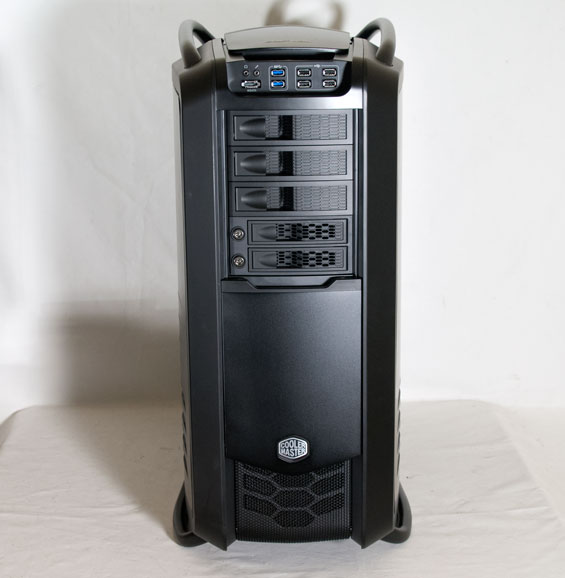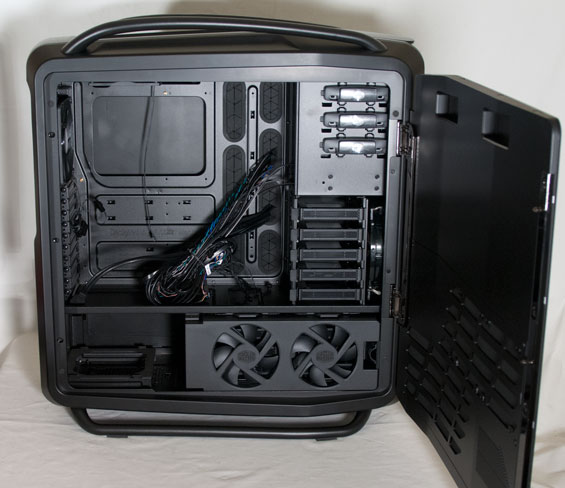Cooler Master Cosmos II: Large and in Charge
by Dustin Sklavos on January 23, 2012 3:20 PM EST- Posted in
- Cases/Cooling/PSUs
- Cooler Master
- Full-Tower
In and Around the Cooler Master Cosmos II
Cooler Master's Cosmos II is a big, fairly attractive hunk of steel, aluminum, and plastic. The black finish with blue LED indicators isn't going to light the world on fire with its stunning originality, but the overall styling is actually just under being too gaudy. Gaming and enthusiast cases always run the risk of looking outlandish or ridiculous, but the Cosmos II is mostly able to avoid the same fate. Honestly, what you're really going to notice is the sheer size of the thing.
Unlike most cases, there's something happening on every side of the Cosmos II. The top has two heavy aluminum bars affixed to the case's steel frame, and those bars are designed pretty much exclusively to help you actually move the enclosure. Between them, to the rear is a giant vent made of tough plastic and metal that's designed to support up to a 360mm watercooling radiator. Towards the front is a control panel with four independent fan control channels, an LED toggle, and the power and reset buttons, masked with a sliding plastic hood.
This hood is where I first ran into trouble. Simply put, it's chintzy, and on my review unit it actually broke off. That hood is held in place with two plastic rails, but one of those was damaged when I received the case, and with a minimal amount of force (if I'm complaining about lifting a 50 pound case, trust me when I say "minimal") the whole thing snapped right off.

When we get to the front of the Cosmos II, under that hood there's a healthy amount of connectivity: four USB 2.0 ports, two USB 3.0 ports, an eSATA port, and the two audio jacks. The external drive bays are actually shielded by a cover that is held to the top of the case magnetically but slides down to reveal them. There are three 5.25" bays protected by plastic drive shields, and then two lockable (and removable) 3.5" hot-swap bays. The front vent is also removable by applying some force to the bottom and lifting upward, but the problem is that when moving the Cosmos II, this is going to be one of the places you'd want to grip it.
The sides are both covered with two hinged doors that have steel frames with aluminum finishes and ventilation at the bottom that lines up with six of the internal 3.5" drive bays; these doors open by pressing levers on the back of the case, but they're also easily removable by just lifting them off the hinges once they're open. Finally, the back is fairly mundane, sporting ten expansion slots plus an eleventh off-center one for extra ports or fan control, a single 140mm exhaust fan, and a removable power supply bracket.

The inside of the Cosmos II is just as spacious and copious as its exterior, and it's broken up into two chambers. The top chamber houses the motherboard (up to XL-ATX) along with a drive cage that holds five 2.5"/3.5" drives on sleds and the five 5.25" drive bays (two of which are occupied by Cooler Master's X-Dock 3.5" docking bay). There are a healthy number of rubber-grommeted routing holes in the motherboard tray, allowing for clean cabling for just about any configuration.
There are cut-outs in the metal divider between the top and bottom chambers, but you'll want to route most of the cable bundle back behind the tray. The bottom chamber has two 120mm fans mounted to an internal hinge that blow cool air across six additional 2.5"/3.5" drive sleds, and then the power supply is also mounted down here. Finally, the area behind the motherboard tray is spacious and easy to route cables in.
There's no real reason to expect assembling the Cosmos II to be difficult outside of its sheer mass, so if you're not a crybaby weakling like I am you'll probably have a much better time with it. Where I get concerned is with the use of chintzy plastic in parts of the assembly. The "fins" around the enclosure are easily bendable and I can see them breaking just like the control panel hood did (especially if you try and lift the case up by them), and while the aluminum finish on parts of the Cosmos II is nice, it's also prone to scratching.
In the reviewer's guide Cooler Master also tells us not to move the case by sliding it along the two bottom rails as it will damage the rails, but that seems ludicrous when the case is so heavy to begin with. I know it's counterintuitive to complain about both the weight and the use of plastic in this enclosure when the plastic is helping keep the weight down, but I feel that speaks to larger issues with the overall design. If you're not planning on moving the Cosmos II very often (and who would?) I can see where this won't be as much of a problem, but keep in mind that the dimensions of the case itself are enormous in the first place.
















53 Comments
View All Comments
Rictorhell - Monday, January 23, 2012 - link
I am a big fan of this site and I read the reviews and articles all of the time and I find them very informative and useful, but, I have a request.When a review is written, particularly about a certain smartphone or tablet, it is mentioned whether the device has an SD card slot and you always tend to differentiate between whether it is a “full-sized” SD slot or a “micro”SD slot. That is useful to know, but there are several actual types of SD cards available, each with a different maximum storage capacity, and you don't specify in your reviews which types of SD cards are actually supported by the device being reviewed and I think that is a bit of an oversight.
To the best of my knowledge, standard SD cards only have a maximum capacity of up to 2gb, while SDHC cards can go up to as high as 32gb, and SDXC cards, while only available right now in sizes up to 128gb, are supposed to theoretically be able to be manufactured in sizes up to 2tb.
There is a huge difference in size between 2gb, 32gb, and 128gb. Given that smartphones and tablets have substantial built in limits as far as storage capacity, I think it would be very helpful to know which type of SD card is supported by which device, if that is possible.
If I read two reviews about two different Android tablets and both reviews mention that both cards have a full-size SD card slot, as a user with a lot of media files, I'm going to be interested to know if one of those tablets can support SDXC cards while the other one cannot.
I consider that to be a major feature, to me, just as important as battery life. If you do reviews of tablets and smartphones, or even ultrabooks, and neglect to specify how much storage potential these devices have or do not have, you are making it very easy for the hardware manufacturers to simply put in second rate storage and format support, knowing that it will not be covered in reviews by sites like Anandech. Not only is this going to stunt the evolution of these devices but it's also going to mean less options for consumers.
Anyway, thank you for your time.
ExarKun333 - Monday, January 23, 2012 - link
Huh? Everything you said is not relevant to this review at all.Sladeofdark - Monday, January 23, 2012 - link
if the USB front panel was facing up like the Cosmos S it would be PERFECT! But i still cant wait to purchase this case to replace my Cosmos S. It has all the improvements ive been wanting in a Chassis for YEARS.. serious cable management, and Serious consideration for hard drive placement. It is like they finally made a case that was not only about making the price point.sviola - Tuesday, January 24, 2012 - link
Agree with you. I too have the Cosmos S, and I wish it would have some of the improvements here like the drive cage facing the side of the cage (but I prefer the red leds on the S model, a bit of the change from the blue led theme that seems to flood the industry).Solidstate89 - Monday, January 23, 2012 - link
After I've had my full of my current build in my Silverstone FT02B case, I'm definitely buying this case and building a behemoth of a system in it. Combined with Windows 8's Storage Spaces, you don't even need a separate Home Server anymore, and that's where all those drive bays will especially come in handy.Risforrocket - Tuesday, January 24, 2012 - link
It's for a build with lots of drives, I agree.I have 4 drives in RAID 10 and am wanting 6 and then the SSD (or two) for the OS. That's 8 drives right there. Lol, I love this case.
Tetracycloide - Wednesday, January 25, 2012 - link
Or a build with a radiator. You loose all of the drive bays in the PSU chamber if you mount a radiator and some pumps down there. I'd argue that's what the chamber was designed for and the bay cages are just tact on so the space still looks useful if you're not water cooling (although it's still wasted space if you don't have all the drive slots filled).Bonesdad - Monday, January 23, 2012 - link
have to agree with some other posters here, this case, though top of the line functionally is big, ugly and fugly. Just my opinion, but no way would I ever own this. I don't think I could even be friends with anyone who owns this.whitehat2k9 - Tuesday, January 24, 2012 - link
The Maximus IV Gene is a Z68 board. Perhaps you meant the upcoming Rampage IV.ggathagan - Wednesday, January 25, 2012 - link
Which doesn't change the overarching point that you can get a fully packed motherboard in the m-ATX form factor, diminishing the need for the full ATX size board in a large majority of situations.